
Space Shuttle Columbia (OV-102) was a Space Shuttle orbiter manufactured by Rockwell International and operated by NASA. Named after the first American ship to circumnavigate the upper North American Pacific coast and the female personification of the United States, Columbia was the first of five Space Shuttle orbiters to fly in space, debuting the Space Shuttle launch vehicle on its maiden flight on April 12, 1981. As only the second full-scale orbiter to be manufactured after the Approach and Landing Test vehicle Enterprise, Columbia retained unique features indicative of its experimental design compared to later orbiters, such as test instrumentation and distinctive black chines. In addition to a heavier fuselage and the retention of an internal airlock throughout its lifetime, these made Columbia the heaviest of the five spacefaring orbiters; around 1,000 kilograms heavier than Challenger and 3,600 kilograms heavier than Endeavour. Columbia also carried ejection seats based on those from the SR-71 during its first six flights until 1983, and from 1986 onwards carried an imaging pod on its vertical stabilizer.
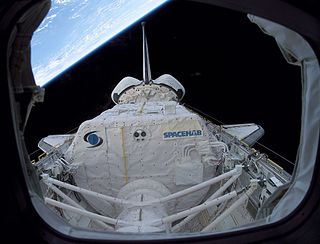
STS-107 was the 113th flight of the Space Shuttle program, and the 28th and final flight of Space Shuttle Columbia. The mission ended, on February 1, 2003, with the Space Shuttle Columbia disaster which killed all seven crew members and destroyed the space shuttle. It was the 88th post-Challenger disaster mission.
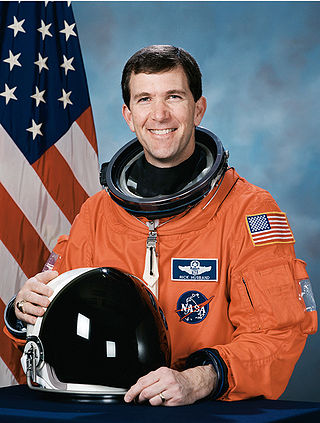
Richard Douglas Husband was an American astronaut and fighter pilot. He traveled into space twice: as pilot of STS-96 and commander of STS-107. Husband and the rest of the crew of STS-107 were killed when Columbia disintegrated during reentry into the Earth's atmosphere. He is also a recipient of the Congressional Space Medal of Honor.
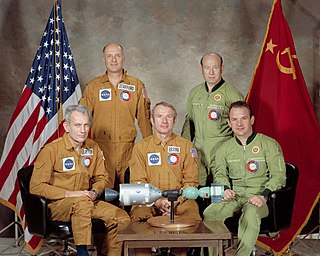
Apollo–Soyuz was the first crewed international space mission, carried out jointly by the United States and the Soviet Union in July 1975. Millions of people around the world watched on television as an American Apollo spacecraft docked with a Soviet Soyuz capsule. The project, and its handshake in space, was a symbol of détente between the two superpowers during the Cold War.

The Columbia Accident Investigation Board (CAIB) was an internal commission convened by NASA to investigate the destruction of the Space Shuttle Columbia during STS-107 upon atmospheric re-entry on February 1, 2003. The panel determined that the accident was caused by foam insulation breaking off from the external fuel tank, forming debris which damaged the orbiter's wing, and that the problem of "debris shedding" was well known but considered "acceptable" by management. The panel also recommended changes that should be made to increase the safety of future shuttle flights. The CAIB released its final report on August 26, 2003.
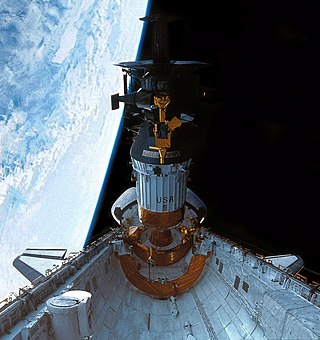
STS-34 was a NASA Space Shuttle mission using Atlantis. It was the 31st shuttle mission overall, and the fifth flight for Atlantis. STS-34 launched from Kennedy Space Center, Florida, on October 18, 1989, and landed at Edwards Air Force Base, California, on October 23, 1989. During the mission, the Jupiter-bound Galileo probe was deployed into space.

STS-95 was a Space Shuttle mission launched from Kennedy Space Center, Florida on 29 October 1998, using the orbiter Discovery. It was the 25th flight of Discovery and the 92nd mission flown since the start of the Space Shuttle program in April 1981. It was a highly publicized mission due to former Project Mercury astronaut and United States Senator John H. Glenn Jr.'s return to space for his second space flight. At age 77, Glenn became the oldest person to go into space, a record that remained unbroken for 23 years until 82-year-old Wally Funk flew on a suborbital flight on Blue Origin NS-16, launching on 20 July 2021, which in turn was broken by William Shatner at age 90 on 13 October 2021. Glenn, however, remains the oldest person to reach Earth orbit. This mission is also noted for inaugurating ATSC HDTV broadcasting in the U.S., with live coast-to-coast coverage of the launch. In another first, Pedro Duque became the first Spaniard in space.

Kevin Richard Kregel is an American former astronaut, and former member of the Space Launch Initiative Project at the Lyndon B. Johnson Space Center.
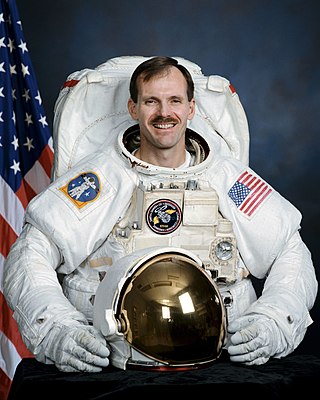
Steven Lee Smith, is an American technology executive and a former NASA astronaut, being a veteran of four space flights covering 16 million miles and seven spacewalks, totaling 49 hours and 25 minutes. Smith’s spacewalk time places him in 14th on the all-time American and World spacewalk duration lists.

The Shuttle–Mir program was a collaborative 11-mission space program between Russia and the United States that involved American Space Shuttles visiting the Russian space station Mir, Russian cosmonauts flying on the Shuttle, and an American astronaut flying aboard a Soyuz spacecraft to engage in long-duration expeditions aboard Mir.

Men Into Space is an American black-and-white science fiction television series, produced by Ziv Television Programs, Inc., that was first broadcast by CBS from September 30, 1959, to September 7, 1960. The series depicts future efforts by the United States Air Force to explore and develop outer space. The series' star, William Lundigan, played Col. Edward McCauley.

Queen of Outer Space is a 1958 American science fiction film shot in DeLuxe Color and CinemaScope. Produced by Ben Schwalb and directed by Edward Bernds, it stars Zsa Zsa Gabor, Eric Fleming, and Laurie Mitchell. The screenplay by Charles Beaumont, about a revolt against a cruel Venusian queen, is based on an idea supplied by Ben Hecht and originally titled Queen of the Universe. Upon its release, the film was promoted by Allied Artists and distributed to some locations as a double feature with Frankenstein 1970 starring Boris Karloff.
The Space Station Biological Research Program is the main project concerning life sciences research to be conducted on the International Space Station. It is a program of NASA's Ames Research Center, with co-operation from other national space agencies. The SSBRP's goal is to study the development, life cycle, and behaviour of certain organisms in the environment of outer space.
"Fun and Games" is an episode of the original The Outer Limits television show. It first aired on 30 March 1964, during the first season.

These are a series of incomplete lists of fictional astronauts appearing in various media, including books, film, television shows, radio shows, records, and comic books.

Garrett Erin Reisman is an American engineer and former NASA astronaut. He was a backup crew member for Expedition 15 and joined Expedition 16 aboard the International Space Station for a short time before becoming a member of Expedition 17. He returned to Earth on June 14, 2008 on board STS-124 on Space Shuttle Discovery. He was a member of the STS-132 mission that traveled to the International Space Station aboard Space Shuttle Atlantis from May 14 to 26, 2010. He is a consultant at SpaceX and a Professor of Astronautics Practice at the University of Southern California's Viterbi School of Engineering.

The following outline is provided as an overview of and topical guide to space exploration.

Space architecture is the theory and practice of designing and building inhabited environments in outer space. This mission statement for space architecture was developed at the World Space Congress in Houston in 2002 by members of the Technical Aerospace Architecture Subcommittee of the American Institute of Aeronautics and Astronautics (AIAA). The architectural approach to spacecraft design addresses the total built environment. It is mainly based on the field of engineering, but also involves diverse disciplines such as physiology, psychology, and sociology.

Women have flown and worked in outer space since almost the beginning of human spaceflight. A considerable number of women from a range of countries have worked in space, though overall women are still significantly less often chosen to go to space than men, and by June, 2020 constitute only 12% of all astronauts who have been to space. Yet, the proportion of women among space travelers is increasing substantially over time.

3022 is a 2019 American science fiction film directed by John Suits and starring Omar Epps, Kate Walsh, Miranda Cosgrove, and Angus Macfadyen. The film is set on a space station in the future. The crew suffers traumatic stress and considers abandoning their mission after they observe what they believe to be the destruction of Earth. The film is shown as a series of flashbacks and flash-forwards.
















